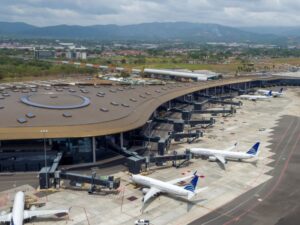Digitalisation is shaking up the world of logistics, opening the doors to greater visibility, connectivity and agility. For the freight forwarding industry, the application of these new technologies has shown huge potential to simplify operations. However, it also presents a strategic challenge and a delicate balancing of priorities, investment, customer demand and capacity. All while navigating the industry’s complexity and fragmentation.
Digitalisation is the use of digital technologies to change a business model and provide new revenue and value-adding opportunities. The COVID-19 pandemic, which brought massive supply chain disruptions and huge growth in ecommerce, accelerated digitalisation in freight forwarding. As the International Federation of Freight Forwarders Association points out, the pandemic exacerbated the need for simplification and supply chain resilience, which digitalisation helped achieve.
The pandemic also supported the growth of digital freight forwarders. Digital forwarders use technologies to organise and coordinate the movement of goods – everything from taking bookings, managing documentation, tracking shipments, and for quotations and invoicing. The digital freight forwarding market, which accounts for about 8% of the total freight forwarding market, is recording steady compound annual growth rate (CARG) of 23%, according to Allied Market Research. In comparison, the global freight forwarding market as whole is recording a compound annual growth rate (CAGR) of 4.2%.
So, what is the extent of digitalisation in freight forwarding today? What does digitalisation offer freight forwarders and their customers? And what does it mean for the future of the industry?
The drivers behind digitalisation in freight forwarding
Supply chains are increasingly globalised and complex with rising customer expectations for faster lead times, expanded services and customised offerings. Digitalisation can help meet many of these requirements, at least in part, and offers the following benefits:
- Visibility and transparency – digitalisation allows for fast data sharing between carriers, suppliers and customers, offering unprecedented visibility and transparency. As Shipping and Freight Resource reports, customers today need “authentic and visual data to see how their products are moving, identify bottlenecks in their supply chain, and correct for where avoidable costs like demurrage, detention and storage are being incurred’. Having access to quality, near real-time data, tracking and monitoring enables better communication and collaboration and makes it easier to plan and complete any forwarding task.
- Speed and efficiency – digitised processes allow the transfer of goods to happen quickly and seamlessly. Any issues in the supply chain can be easily identified and addressed. Technology also means many repetitive, time-consuming processes can be automated to reduce errors, and improve efficiency. The Boston Consulting Group calculated that automating back-office and operations can help reduce costs by up to 40%.
- Scalability – digitalisation levels the playing field and allows freight forwarders, regardless of their size, to do more with less. Any human resources a freight forwarder has can be optimised and supported by the automation of back-office operations such as emails, freight tracking or quote generation. As the Boston Consulting Group points out, this is the case with digital forwarders who can more easily offer more services and cover a larger geographic area.
- Flexibility and agility – digitalisation allows for ad hoc planning and real-time responses to changes in demand or supply, or disruptions. Digitalisation improves end to end visibility, so any issue can be quickly identified or even anticipated, and the best workaround implemented. In addition, when the freight forwarders are better connected to carriers and customers, their capacity to act quickly and respond to disruptions is vastly improved.
- Improved customer experience – the Cooperative Logistics Network, which represents freight forwarders around the world, states that good customer service in freight forwarding involves value-added services, timely delivery, and immediate response. Digital technologies ensure freight forwarders’ customers can easily search, book, amend and track bookings. For example, a quote that could previously have taken a forwarder days or weeks to prepare and send, can be calculated and issued almost immediately thanks to automation.
- Sustainability – freight transportation accounts for 8% of global emissions and is expected to become the highest emitting sector by 2030, according to the Intergovernmental Panel on Climate Change (IPCC). Digitalisation has the potential to help freight forwarders monitor emissions and identify areas where they can be reduced. Big data enables better decision-making and optimisation for more environmentally friendly operations and improving sustainability in logistics.
Get insights from an industry insider
Enter our world of truly integrated logistics. Be inspired and gain knowledge on relevant business insights, in a few clicks.

Overcoming the barriers to digitalisation in forwarding
According to new Accenture research, freight forwarders have ‘mastered the art of doing more with less’ with digitalisation. Across the logistics industry, freights forwarders’ spending on digital innovation below average, but their digital capabilities are significant. In all, 69% of freight forwarders surveyed said the data from their different systems (including transport management, warehouse management and customs brokerage) is fully integrated, while many have introduced ‘track and trace’ capabilities since the pandemic. However, many freight forwarders are still to realise the full potential of e-booking, online quotation and automatic invoicing capabilities.
One of the key barriers to digitalisation relates to the cost of introducing technologies. As a Loadstar article explains, often freight forwarders are sceptical that new technology solutions will deliver positive change. In addition, there may be a lack of knowledge on how to digitalise a business or what aspects to focus on digitalise first. The process of digitalisation in freight forwarding requires an investment in the technology, but also in adapting business process and operations, and upskilling staff.
The first step towards digitalisation for many traditional forwarders was to introduce a transport management system (TMS), which allows them to automate vital operations and draw insights along the way. A TMS can handle many department operations, including accounting, office management and freight shipping. This can help reduce manual processes, improve decision-making capacity, automate operations. The global TMS market is current valued at USD 11.7 billion and is expected to grow to USD 28 billion by 2027. According to a survey by Peerless Research Group, half of TMS users reported achieving a return on investment on the software withing 12 months or less.
As Global Trade reports, huge advancement with TMS has been the transition to systems that are API-based. API (application program interface) systems are usually cloud-based and allow different applications, regardless of their design or code, to exchange data and information with each other. This means forwarders can have a direct connection with clients and carriers to communicate and exchange data such as names, data, product information, inventories, carrier rates, etc. API-based systems allow for automation, customisation and adaptation.
The digitalisation of traditional freight forwarders is happening alongside the growth of digital forwarders. Ti Insights calculated that digital freight forwarding startups attracted around USD 1.2 billion in funding in the first quarter of 2022 alone. This amount of investment was greater than for the full year of 2021. In the most recent TI Insights report, 47.7% of goods volume went through digital forwarders’ platforms in 2022. This is expected to increase to over 60% by 2027 as the digital forwarders grow and their technology evolves. Customers choosing digital forwarders said they valued their approach to tracing and visibility, invoicing and payment, and the speed of service. However, there were areas where they were yet to catch up to traditional forwarders, particularly in value-added services and exception management. However, Ti Insights concludes that its research shows ‘the differences between the digital and traditional freight forwarding models are gradually fading, to the benefit of the entire industry’.
Where to from here for digitalisation in freight forwarding
The research shows there is strong recognition across the industry that IT capabilities matter, but that they needed to be matched with expertise in managing complex processes.
Deloitte notes that to continue advancing, digitalisation in freight forwarding needs to understand and accommodate the need for customisation, the complexity of operations and the need to involve multipoles parties, and technological competency. Only digitalisation that supports simplification and growth will continue to attract investment and inspire other freight forwarders to advance their digitalisation.
The process of digitalisation in freight forwarding is underway. Many say it is unavoidable and that advanced analytics, robotics, and digital front ends will be the future, paired with increasingly automated and integrated back-end operations. However, the pace of digitalisation and the adoption of technologies will vary, depending largely on the acceptance and understanding of its potential to streamline and simplify.
![]()
































